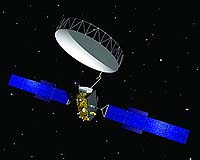 |
Paris, France (SPX) Jun 19, 2009 ST-2 Satellite Ventures Pte Ltd (STS), a joint venture formed by Singapore Telecommunications Ltd (SingTel) and Chunghwa Telecom Company Ltd (Chunghwa), has chosen Arianespace to launch its new telecommunications satellite, ST-2. This satellite will replace ST-1 launched by Arianespace in 1998. ST-2 will be launched by an Ariane 5 ECA during the second quarter of 2011 from the Guiana Space Center, Europe's Spaceport in French Guiana. The satellite will be built by Mitsubishi Electric Corporation of Japan, using the DS2000 platform and will have a lift-off mass of more than 5 100 kg. The satellite will carry C and Ku band transponders providing fixed and mobile satellite services as well as Voice and Data IP based services for businesses, particularly DTH operators and Shipping companies in Asia and the Middle East. ST-2 will have a 15 year on orbit lifetime. For Jean-Yves Le Gall, Chairman and CEO of Arianespace, "Arianespace is particularly proud to serve again SingTel and Chunghwa with whom we have maintained warm relations since the launch of ST-1 in 1998. This new contract, the 9th to be signed in 2009, is for us the recognition of the quality and competitiveness of Arianespace's services and solutions launch offer."
related report Arianespace and EADS CASA Espacio have worked together since the beginning of the Ariane program. Structures made by EADS CASA Espacio for the inter-stage skirts and inter-tanks skirts have been used on all Ariane launchers to date. Commenting on this contract, Arianespace Chairman and CEO Jean-Yves Le Gall said: "EADS CASA Espacio has produced components for this launcher since the first Ariane launch in 1979, including parts for the structure, payload interface, separation rings, shock attenuation system, electronic units and piping. Arianespace has always been able to count on the quality and reliability of structural parts produced by EADS CASA Espacio."
related report Despite the global economic crisis Arianespace enjoyed a remarkable year, as it signed 13 contracts out of the total of 18 open to competition, clearly confirming its world leadership position. Arianespace posted sales of euros 955.7 million in 2008, with net income of 2.5 million euros (the sixth year in a row that Arianespace finished in the black). With 30 successful launches in a row, the Ariane 5 launcher continued to confirm its technical maturity. Ariane 5 is the only commercial launcher on the market capable of simultaneously launching two payloads, to give Arianespace customers outstanding performance, flexibility and competitiveness. The objective for 2009 is to carry out seven Ariane 5 launches. The launcher has already completed two successful missions, on February 12 and May 14. The next Ariane launch is scheduled for July 1: an Ariane 5 ECA will boost TerreStar-1, the largest communications satellite ever built, into geostationary transfer orbit (GTO). Since the beginning of the year, Arianespace has won ten new GTO launch contracts (Hispasat 1E, Arabsat 5C and Badr 7, Yamal 401 and 402, Intelsat New Dawn, JCSAT-13, Alphasat I-XL, ST-2, et ABS-2) and two contracts for launches into medium Earth orbit, or MEO (2 Soyuz launches from French Guiana to launch four Galileo IOV satellites). Building on its family of launchers, Arianespace now has a significant backlog of launch contracts from 30 different customers: + 35 satellites to be launched into geostationary transfer orbit, using Ariane 5, or Soyuz for the smaller satellites. + 7 government launches by Ariane 5, including 6 for the ATV. + 9 dedicated Soyuz launches.
A Guaranteed independant access to space for Europe These contracts clearly confirm the commitment of Arianespace and the entire European space industry to guarantee the long-term availability, reliability and competitiveness of Ariane 5. The report on European space recently submitted to the French prime minister confirms that Europe's independent access to space is inextricably linked with commercial success. The successor to Ariane 5 will also have to integrate market requirements, allowing Arianespace to retain its global leadership. Arianespace also signed an agreement with the European Space Agency at this year's Paris Air Show, defining the conditions for the procurement of launch services by ESA and favoring a European solution for these launches.
Soyuz and Vega: two new launch systems The first two Soyuz launchers will arrive in French Guiana in November, and the first launch is scheduled for the first few weeks of 2010. A total of 14 Soyuz launchers have been ordered, so that operations from the Guiana Space Center can kick off with availability to meet market expectations, underscored by the recent signature of new contracts. Refurbishment of the ELA-1 launch pad for the Vega light launcher is nearly finished, including the initial rolling tests of the mobile gantry. Each of the three solid propulsion stages has successfully passed two static firing tests prior to launch. Vega is scheduled to enter service at the Guiana Space Center in 2010. Share This Article With Planet Earth
Related Links Arianespace Launch Pad at Space-Travel.com
 Arianespace Chosen To Launch Alphasat
Arianespace Chosen To Launch AlphasatParis, France (SPX) May 21, 2009 Inmarsat has chosen Arianespace to launch its new Alphasat I-XL communications satellite. This contract follows a partnership agreement between Inmarsat and the European Space Agency (ESA) concerning the commercialization of the first mission to use the new European platform, Alphabus. Planned for launch in 2012, Alphasat I-XL will be carried by an Ariane 5 ECA in from the Guiana Space Cen ... read more |
|
| The content herein, unless otherwise known to be public domain, are Copyright 1995-2009 - SpaceDaily. AFP and UPI Wire Stories are copyright Agence France-Presse and United Press International. ESA Portal Reports are copyright European Space Agency. All NASA sourced material is public domain. Additional copyrights may apply in whole or part to other bona fide parties. Advertising does not imply endorsement,agreement or approval of any opinions, statements or information provided by SpaceDaily on any Web page published or hosted by SpaceDaily. Privacy Statement |